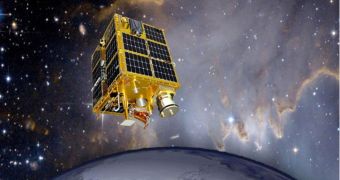For the first time ever, researchers at the American space agency combined a variety of readings from different spacecraft in order to create a comprehensive view of Earth's environment. The team was especially focused on electromagnetic fields and on the particles that permeated this neighborhood.
One of the main objectives was to understand how electric and magnetic fields remain in constant motion, and also how particles emanating from both the planet's atmosphere and the Sun interact to underly these phenomena.
Charged particles are of special interest to scientists, since they are largely responsible for creating amazing aurora displays when they combine with Earth's magnetic field lines. Solar flares and coronal mass ejections produced most of the particles that create auroras.
The Miniature Imager for Neutral Ionospheric Atoms and Magnetospheric Electrons (MINI-ME) instrument aboard the NASA FASTSAT microsatellite is keeping close tabs not on solar particles, but on those released by Earth's upper atmosphere.
By combining MINI-ME data with information collected by two other instruments, experts were able to observe electric currents and outflowing particles occurring simultaneously for the first time.
“We're seeing structures that are fairly consistent throughout a handful of instruments. We put all of these observations together and it tells a story greater than the sum of its parts,” Michael Collier says.
The expert – who holds an appointment at the NASA Goddard Space Flight Center (GSFC), in Greenbelt, Maryland – is the principal investigator of the MINI-ME instrument. The microsatellite which carries it is the first of its kind, and it was launched on November 19, 2010.
The tool determined that the upper atmosphere is releasing oxygen ions alongside magnetic field lines. Interestingly, it was calculated that the strength of this ion outflow is heavily dependent on the amount of charged particles released by the Sun at any given time.
In regions of the planet where aurora displays are especially intense – such as the poles – the amount of oxygen ions being removed by solar flares is highest, experts report. “These ion outflow events are important because they help us understand the space weather environment around Earth,” says Doug Rowland
“The heavy ions flowing away from Earth can act as a brake, or damper, on incoming energy from the solar wind,” adds the GSFC expert, who is the principal investigator of the Plasma Impedance Spectrum Analyzer (PISA) instrument on FASTSAT.
“The flow also indicates ways in which planets can lose their atmospheres – something that happens slowly on Earth, but more quickly on smaller planets with weaker magnetic fields, like Mars,” he concludes.

 14 DAY TRIAL //
14 DAY TRIAL //